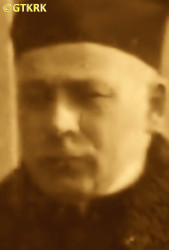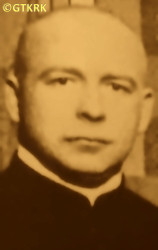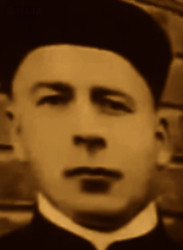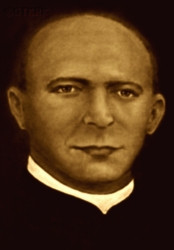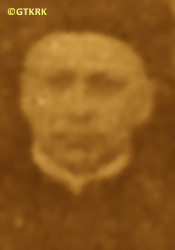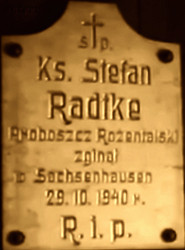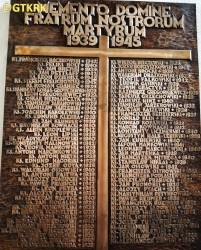Roman Catholic
St Sigismund parish
05-507 Słomczyn
85 Wiślana Str.
Konstancin deanery
Warsaw archdiocese, Poland
full list:
displayClick to display full list

searchClick to search full list by categories
wyświetlKliknij by wyświetlić pełną listę po polsku

szukajKliknij by przeszukać listę wg kategorii po polsku

Martyrology of the clergy — Poland
XX century (1914 – 1989)
personal data
religious status
Servant of God
surname
RADTKE
forename(s)
Steven Boleslav (pl. Stefan Bolesław)
forename(s)
versions/aliases
Stephen (pl. Szczepan)
function
diocesan priest
creed
Latin (Roman Catholic) Church RCmore on
en.wikipedia.org
[access: 2014.09.21]
diocese / province
Culm (Chełmno) diocesemore on
pl.wikipedia.org
[access: 2012.11.23]
honorary titles
„Iron Cross” i.e. Germ. „Eisernes Kreuz” (German Empire) — 2nd classmore on
en.wikipedia.org
[access: 2020.04.25]
date and place
of death
29.10.1940

KL Sachsenhausenconcentration camp
today: Sachsenhausen‐Oranienburg, Oberhavel dist., Brandenburg state, Germany
more on
en.wikipedia.org
[access: 2018.11.18]
details of death
During World War I drafted on 01.07.1915 into German army as a nurse in military hospital in Gdynia. Sent to Western front. Awarded German Iron Cross 2nd class. In 1916 taken POW by French at the front near Somma river and released in 03.1920.
After German invasion of Poland on 01.09.1939 (Russians invaded Poland 17 days later) and start of World War II, after start of German occupation, arrested by the Germans early on 05.09.1939.
Imprisoned successively in arrests and prisons in Olsztynek and Nowe Miasto Lubawskie.
Released there.
Arrested again by the Germans on 14.11.1939.
Imprisoned in Lubawa, again in Nowe Miasto Lubawskie and VSH Rypin.
From there, on 16.11.1939, sent to the VSH Obory transit camp in Obory.
Then, on 22.02.1940, transported to a transit camp in Grudziądz and on 04‐05.03.1940 to the KL Stutthof concentration camp.
From there sent to the ZL Grenzdorf subcamp, where on 26.03‐06.04.1940 slaved in a quarry.
After a short return to KL Stutthof, finally on 09‐10.04.1940 transported to the KL Sachsenhausen concentration camp, where perished — the Germans attempted to persuade him to sign the list of German nationality, i.e. the Germ. Deutsche Volksliste DVL, that could save his life, but refused.
According to the death certificate in the books of the Germ. Standesamt (Eng. registry office) in Oranienburg, No. 3868/40, the „honest” otherwise German „medical doctors” and formalists — and at the same time, unrivaled fairy tale spinners — noted that the cause of death was Germ. „Eitrige Gelenkentzündung” (Eng. „Purulent arthritis”).
prisoner camp's numbers
21108Click to display source page (KL SachsenhausenClick to display the description)
cause of death
extermination: exhaustion and starvation
perpetrators
Germans
sites and events
KL SachsenhausenClick to display the description, ZL GrenzdorfClick to display the description, KL StutthofClick to display the description, VSH GraudenzClick to display the description, VSH OboryClick to display the description, VSH RypinClick to display the description, «Intelligenzaktion»Click to display the description, Reichsgau Danzig‐WestpreußenClick to display the description, Ribbentrop‐MolotovClick to display the description, Pius XI's encyclicalsClick to display the description
date and place
of birth
02.03.1890Birth certification on:
metryki.genbaza.pl
[access: 2025.11.10]

Dębogórzetoday: Kosakowo gm., Puck pov., Pomerania voiv., Poland
more on
en.wikipedia.org
[access: 2022.01.28]
parents
RADTKE Joseph
🞲 ?, ? — 🕆 ?, ?

MAGRYAN Julianna
🞲 ?, ? — 🕆 ?, ?
presbyter (holy orders)
ordination
14.06.1924

Pelplintoday: Pelplin gm., Tczew pov., Pomerania voiv., Poland
more on
en.wikipedia.org
[access: 2021.05.06]
St Barbara RC chapelmore on
pl.wikipedia.org
[access: 2021.12.19] (in Theological Seminary)
positions held
1938 – 1939
parish priest — Rożentaltoday: Lubawa gm., Iława pov., Warmia‐Masuria voiv., Poland
more on
en.wikipedia.org
[access: 2021.09.02] ⋄ St Lawrence the Deacon and Martyr RC parish ⋄ Lubawatoday: Lubawa urban gm., Iława pov., Warmia‐Masuria voiv., Poland
more on
en.wikipedia.org
[access: 2021.09.02] RC deanery
1933 – 1938
curatus/rector/expositus — Gdynia ‐ Mały Kackparish seat name
today: district of Gdynia, Gdynia city pov., Pomerania voiv., Poland
more on
pl.wikipedia.org
[access: 2021.12.19] ⋄ Christ the King RC church ⋄ Gdynia ‐ Wielki Kackparish seat name
today: district of Gdynia, Gdynia city pov., Pomerania voiv., Poland
more on
pl.wikipedia.org
[access: 2021.12.19], St Lawrence the Martyr RC parish ⋄ Gdyniatoday: Gdynia city pov., Pomerania voiv., Poland
more on
en.wikipedia.org
[access: 2021.09.02] RC deanery
1931 – 1932
curatus/rector/expositus — Łebcztoday: Puck gm., Puck pov., Pomerania voiv., Poland
more on
en.wikipedia.org
[access: 2022.02.24] ⋄ St Martin the Bishop and Confessor RC curacy ⋄ Swarzewotoday: Puck gm., Puck pov., Pomerania voiv., Poland
more on
en.wikipedia.org
[access: 2021.03.16], Nativity of the Blessed Virgin Mary RC parish ⋄ Pucktoday: Puck gm., Puck pov., Pomerania voiv., Poland
more on
en.wikipedia.org
[access: 2021.07.18] RC deanery
1930
vicar — Osietoday: Osie gm., Świecie pov., Kuyavia‐Pomerania voiv., Poland
more on
en.wikipedia.org
[access: 2021.09.02] ⋄ Exaltation of the Holy Cross RC parish ⋄ Świecietoday: Świecie gm., Świecie pov., Kuyavia‐Pomerania voiv., Poland
more on
en.wikipedia.org
[access: 2021.09.02] RC deanery
1930
vicar — Zwiniarztoday: Grodziczno gm., Nowe Miasto Lubawskie pov., Warmia‐Masuria voiv., Poland
more on
en.wikipedia.org
[access: 2021.12.19] ⋄ St Nicholas the Bishop and Confessor RC parish ⋄ Lubawatoday: Lubawa urban gm., Iława pov., Warmia‐Masuria voiv., Poland
more on
en.wikipedia.org
[access: 2021.09.02] RC deanery
1930
vicar — Cekcyn Polskitoday: Cekcyn, Cekcyn gm., Ignalina pov., Kuyavia‐Pomerania voiv., Poland
more on
en.wikipedia.org
[access: 2021.09.02] ⋄ Exaltation of the Holy Cross RC parish ⋄ Tucholatoday: Tuchola gm., Tuchola pov., Kuyavia‐Pomerania voiv., Poland
more on
en.wikipedia.org
[access: 2021.09.02] RC deanery
1929
vicar — Drzycimtoday: Drzycim gm., Świecie pov., Kuyavia‐Pomerania voiv., Poland
more on
en.wikipedia.org
[access: 2021.09.02] ⋄ Purification of the Blessed Virgin Mary and All the Saints RC parish ⋄ Świecietoday: Świecie gm., Świecie pov., Kuyavia‐Pomerania voiv., Poland
more on
en.wikipedia.org
[access: 2021.09.02] RC deanery
1927 – 1929
vicar — Papowo Biskupietoday: Papowo Biskupie gm., Chełmno pov., Kuyavia‐Pomerania voiv., Poland
more on
en.wikipedia.org
[access: 2021.12.18] ⋄ St Nicholas the Bishop and Confessor RC parish ⋄ Chełmżatoday: Chełmża urban gm., Toruń pov., Kuyavia‐Pomerania voiv., Poland
more on
en.wikipedia.org
[access: 2021.09.02] RC deanery
1924 – 1927
vicar — Miłobądztoday: Tczew gm., Tczew pov., Pomerania voiv., Poland
more on
en.wikipedia.org
[access: 2021.09.02] ⋄ St Margaret the Martyr RC parish ⋄ Tczewtoday: Tczew urban gm., Tczew pov., Pomerania voiv., Poland
more on
en.wikipedia.org
[access: 2021.09.02] RC deanery
1924
vicar — Chełmżatoday: Chełmża urban gm., Toruń pov., Kuyavia‐Pomerania voiv., Poland
more on
en.wikipedia.org
[access: 2021.09.02] ⋄ Holy Trinity RC parish ⋄ Chełmżatoday: Chełmża urban gm., Toruń pov., Kuyavia‐Pomerania voiv., Poland
more on
en.wikipedia.org
[access: 2021.09.02] RC deanery
1920 – 1924
student — Pelplintoday: Pelplin gm., Tczew pov., Pomerania voiv., Poland
more on
en.wikipedia.org
[access: 2021.05.06] ⋄ philosophy and theology, Theological Seminary
01.07.1915 – 1916
soldier — German Imperial Army — initially a medic at the military hospital in Gdynia, then on the Western Front, participant in the largest battle of World War I, 01.07‐18.11.1916, on the Somme, taken POW
pupil — Elblągtoday: Elbląg city pov., Warmia‐Masuria voiv., Poland
more on
en.wikipedia.org
[access: 2022.04.12] ⋄ Germ. Königliche Gymnasium (Eng. Royal Gymnasium) — studies crowned with the maturity diploma (i.e. matura)
from 1907
pupil — Wejherowotoday: Wejherowo gm., Wejherowo pov., Pomerania voiv., Poland
more on
en.wikipedia.org
[access: 2021.09.02] ⋄ Germ. Königliche Gymnasium (Eng. Royal Gymnasium)
others related
in death
ADAMCZYKClick to display biography Stanislav, BRZĄKAŁAClick to display biography Victor, BURCZYKClick to display biography Felix, BYTOFClick to display biography Peter, CHARSZEWSKIClick to display biography Paulinus Ignatius, CHYLARECKIClick to display biography Stanislav, CIEMNIAKClick to display biography Louis, CYBULSKIClick to display biography Stanislav, CZAKIClick to display biography Saturnin, CZAPIEWSKIClick to display biography Joseph Leonard, DEMSKIClick to display biography Vladislav, DOERINGClick to display biography Alexander, FIGATClick to display biography Henry, GOŃCZClick to display biography Bernard Ambrose, GORALClick to display biography Vladislav, GRZEBIELEWSKIClick to display biography Joseph, GUZClick to display biography Joseph Adalbert (Fr Innocent), HEVELKEClick to display biography Alexander Eugene John Oscar, HINZClick to display biography Francis Felix, HINZClick to display biography Thaddeus, JARZĘBSKIClick to display biography Stanislav Romualdo, JORDANClick to display biography Boleslav, KALINOWSKIClick to display biography Theodore, KARAMUCKIClick to display biography Edmund Leo, KARCZYŃSKIClick to display biography Cyril Methodius, KAŹMIERCZAKClick to display biography Bronislav Anthony, KLEINClick to display biography John Matthias, KOMPFClick to display biography January Sigismund, KONKOLEWSKIClick to display biography Joachim, KOWNACKIClick to display biography Bronislav, KOZUBEKClick to display biography Roman, KRAUZEClick to display biography Edmund, KRUPIŃSKIClick to display biography Louis, KUBIAKClick to display biography John (Bro. Norbert Mary), KUBICKIClick to display biography Steven Adam Marian, KUBISTAClick to display biography Stanislav, KUPILASClick to display biography Francis, LAPISClick to display biography Casimir, LENARTClick to display biography John, LICZNERSKIClick to display biography Constantine John, ŁOSIŃSKIClick to display biography Bernard Anthony, MACIĄTEKClick to display biography Stanislav Paul, MARCHLEWSKIClick to display biography Leonard, MATUSZEWSKIClick to display biography Francis Adam, MĄKOWSKIClick to display biography John, MĘŻNICKIClick to display biography Joseph, MICHNOWSKIClick to display biography Marian John, MITRĘGAClick to display biography Francis, MORKOWSKIClick to display biography Edmund, MOŚCICKIClick to display biography Joseph, NAGÓRSKIClick to display biography Paul Adalbert, NITSCHMANNClick to display biography Adam Robert, NOWAŃSKIClick to display biography Anthony, NOWICKIClick to display biography Alexander, OCHOŃSKIClick to display biography Charles Joseph (Fr Chris), OKOŁO–KUŁAKClick to display biography Anthony, PALUCHOWSKIClick to display biography Boleslav, PETRYKOWSKIClick to display biography Steven, PIASZCZYŃSKIClick to display biography Michael, PODLASZEWSKIClick to display biography Francis, POMIANOWSKIClick to display biography Vladislav, SĄSAŁAClick to display biography Theodore, SKOBLEWSKIClick to display biography Mieczyslav, SKOWRONClick to display biography Casimir, SOCHACZEWSKIClick to display biography Bronislav Peter, SWINARSKI–PORAJClick to display biography Nicholas Ignatius Bogusław, SYNOWIECClick to display biography Boleslav, SZUKALSKIClick to display biography John Wladysław, SZYMAŃSKIClick to display biography Bruno Peter John, ŚLEDZIŃSKIClick to display biography Joseph Marian, TUSZYŃSKIClick to display biography Joseph, TYMIŃSKIClick to display biography Anthony, WAWRZYNOWICZClick to display biography John, WĄSOWICZClick to display biography Sigismund, WIERZBICKIClick to display biography Sigismund Lawrence, WIERZCHOWSKIClick to display biography Fabian Sebastian, WILLIMSKYClick to display biography Albert, WŁODARCZYKClick to display biography Ignatius, WOHLFEILClick to display biography Robert, WRÓBLEWSKIClick to display biography Bronislav, ZAWISZAClick to display biography Valentine, ZIELIŃSKIClick to display biography Paul Nicholas, ZIEMSKIClick to display biography Alexander Felix, ZIENKOWSKIClick to display biography Vaclav, ŻUCHOWSKIClick to display biography Vaclav, BATKOClick to display biography Alexander, BORZYSZKOWSKIClick to display biography Joseph, BUSZTAClick to display biography Anthony (Fr Simon), FLACZYŃSKIClick to display biography Francis, GAJEWSKIClick to display biography Vladislav, GOGOLEWSKIClick to display biography Stanislav, GRABOWSKIClick to display biography Sigismund, JARANOWSKIClick to display biography Constantine Stanislav, KACZOROWSKIClick to display biography Michael, MAKOWSKIClick to display biography Paul (Fr Bruno), MALINOWSKIClick to display biography Constantine Peter, MATEUSZCZYKClick to display biography Theodore, NOWAKClick to display biography Stanislav Zeno, OSTROWSKIClick to display biography Francis Xavier, PĘDZICHClick to display biography Boleslav, PRABUCKIClick to display biography Boleslav Rock, PRYBAClick to display biography Leo Simon, SŁAWIŃSKIClick to display biography Stanislav, WALCZAKClick to display biography Mary (Sr Theodosia), WILAMOWSKIClick to display biography Alexander, BIELEŃClick to display biography Anthony, BOJUŁKAClick to display biography Bronislav Francis, BROCKIClick to display biography Anthony, CZUBEKClick to display biography Joseph, GASIŃSKIClick to display biography Louis, GOŁĘBIEWSKIClick to display biography Joseph Lawrence, GREGORKIEWICZClick to display biography Leo, KĘDZIERSKIClick to display biography Francis, KLUNDERClick to display biography John, KOPAŃSKIClick to display biography Conrad, KOWNACKIClick to display biography Martin Stanislav, ŁĘGOWSKIClick to display biography Vladislav Leonard, ŁUBIEŃSKIClick to display biography John Boleslav, MAŃKOWSKIClick to display biography Alphonse, MARTENKAClick to display biography John, MIĘTKIClick to display biography Anthony, NAGÓRSKIClick to display biography Edmund Marian, NIKLASClick to display biography Stanislav, ODYAClick to display biography Joseph Florian, ODYAClick to display biography Lucyn Joseph, OLSZEWSKIClick to display biography Edward, OSSOWSKIClick to display biography John Anthony, PARTYKAClick to display biography Boleslav, PASTWAClick to display biography Anthony, PTACHClick to display biography Louis Paul, ROGALSKIClick to display biography John, SADOWSKIClick to display biography Anastasius, SOBISZClick to display biography Anthony, SOWIŃSKIClick to display biography Emil Bronislav, STELLAClick to display biography Joseph, WILCZEWSKIClick to display biography Francis Joseph, WOLSKIClick to display biography Vaclav
sites and events
descriptions
KL Sachsenhausen: In Germ. Konzentrationslager (Eng. concentration camp) KL Sachsenhausen, set up in the former Olympic village in 07.1936, hundreds of Polish priests were held in 1940, before being transported to KL Dachau. Some of them perished in KL Sachsenhausen. Murderous medical experiments on prisoners were carried out in the camp. In 1942‐1944 c. 140 prisoners slaved at manufacturing false British pounds, passports, visas, stamps and other documents. Other prisoners also had to do slave work, for Heinkel aircraft manufacturer, AEG and Siemens among others. On average c. 50,000 prisoners were held at any time. Altogether more than 200,000 inmates were in jailed in KL Sachsenhausen and its branched, out of which tens of thousands perished. Prior to Russian arrival mass evacuation was ordered by the Germans and c. 80,000 prisoners were marched west in so‐called „death marches” to other camps, i.e. KL Mauthausen‐Gusen and KL Bergen‐Belsen. The camp got liberated on 22.04.1945. After end of armed hostilities Germans set up there secret camp for German prisoners and „suspicious” Russian soldiers. (more on: en.wikipedia.orgClick to attempt to display webpage
[access: 2018.11.18])
ZL Grenzdorf: German Germ. Zivilgefangenenlager (Eng. camp for civilians) in Graniczna Wieś village. Existed in 1939‐1941. In 1940 — when in became a sub‐camp of KL Stutthof concentration camp and as such was known as Germ. Aussenstelle (Eng. external camp) — c. 100 Polish priests from Pomerania — as a part of «Intelligenzaktion» aimed at extermination of Polish intelligentsia and ruling classes in Pomerania — were kept there and forced to slave at manufacturing of road bricks. (more on: pl.wikipedia.orgClick to attempt to display webpage
[access: 2014.03.10])
KL Stutthof: In German Germ. Konzentrationslager (Eng. concentration camp) KL Stutthof (then in Eastern Prussian belonging to Germany, today: Sztutowo village) concentration camp, that Germans started to build on 02.09.1939, a day after German invasion of Poland and start of the World War II, Germans held c. 110,000‐127,000 prisoners from 28 countries, including 49,000 women and children. C. 65,000 victims were murdered and exterminated. In the period of 25.01‐27.04.1945 in the face of approaching Russian army Germans evacuated the camp. When on 09.05.1945 Russians soldiers entered the camp only 100 prisoners were still there. In an initial period (1939‐1940) Polish Catholic priests from Pomerania were held captive there before being transported to KL Dachau concentration camp. Some of them were murdered in KL Stutthof or vicinity (for instance in Stegna forest). Also later some Catholic priests were held in KL Stutthof. (more on: stutthof.orgClick to attempt to display webpage
[access: 2018.11.18], en.wikipedia.orgClick to attempt to display webpage
[access: 2013.07.06])
VSH Graudenz: As part of «Intelligenzaktion» — physical extermination of Polish intelligentsia from Pomerania — Germans initially in 09.1939 held Poles captive in investigative prison in Grudziądz. After it became too small the genocidal German paramilitary organization Volksdeutscher Selbstschutz — the decision to create Selbstschutz in the Polish lands occupied by German troops was made in Berlin on 08‐10.09.1939 at a conference headed by Reichsführer‐SS Heinrich Himmler (the formal order bears the date 20.09.1939), and the chaotically formed units were directly subordinated to the officers of the genocidal SS organization — organized the Germ. Volksdeutscher Selbstschutzhaft (Eng. Volksdeutscher Selbstschutz custody) VSH in the building of the so‐called Borderlands Hostel building at Chopin Str. (on 31.03.1937, before German invasion, it housed 97 boys). In this building Germans held captive 4,000 to 5,000 Poles, including c. 150 local priests and c. 100 teachers and students of the local teachers' seminary. Most of them were subsequently murdered in local forests (Księże Góry, Mniszek‐Grupa), some were taken to concentration camps and 200 boys — residents of the Borderlands Hostel — were after some time deported as slave laborers to Germany. Everything was obviously done in accordance with „German law” — there was an ad hoc Volksdeutscher Selbstschutz kangaroo court in the camp, which „issued sentences” deciding on the fate of imprisoned Poles. (more on: pl.wikipedia.orgClick to attempt to display webpage
[access: 2013.01.13])
VSH Obory: German Germ. Volksdeutscher Selbstschutzhaft (Eng. Volksdeutscher Selbstschutz custody) VSH for the clergy of the Dobrzyń region (in Płock diocese) and neighbouring parishes of Chełmno diocese, established on 30.10.1939 by Germans, members of the genocidal paramilitary Germ. Volksdeutscher Selbstschutz formation — the decision to create Selbstschutz in the Polish lands occupied by German troops was made in Berlin on 08‐10.09.1939 at a conference headed by Reichsführer‐SS Heinrich Himmler (the formal order bears the date 20.09.1939), and the chaotically formed units were directly subordinated to the officers of the genocidal SS organization — Germ. Geheime Staatspolizei (Eng. State Secret Police), i.e. Gestapo, in Carmelite Fathers OCarm monastery in Obory village c. 18 km form Golub–Dobrzyń. Till 22.02.1940 in a Carmelite fathers’ convent Germans held captive — in extremely difficult conditions, in the middle of a very hard winter, without heating or outer clothes, on unchanged straw in cold cells, without food (saved only by the local residents who shared with them their own food), forced to perform forced slave labor — 52 Catholic priest and 3 nuns. Almost all (apart from two, denounced by local German population, were driven out of the camp and murdered in public mass execution of Poles) were deported to concentration camps: initially KL Stutthof and KL Sachsenhausen. Most of them perished there. (more on: pl.wikipedia.orgClick to attempt to display webpage
[access: 2013.08.17], www.obory.com.plClick to attempt to display webpage
[access: 2012.12.28])
VSH Rypin: German Germ. Volksdeutscher Selbstschutzhaft (Eng. Volksdeutscher Selbstschutz custody) VSH for the inhabitants of the Dobrzyń region founded in 09/10.1939 by Germans, members of the genocidal paramilitary Germ. Volksdeutscher Selbstschutz formation — the decision to create Selbstschutz in the Polish lands occupied by German troops was made in Berlin on 08‐10.09.1939 at a conference headed by Reichsführer‐SS Heinrich Himmler (the formal order bears the date 20.09.1939), and the chaotically formed units were directly subordinated to the officers of the genocidal SS organization. Rypin the Germans captured on 07.09.1939. Based on the German minority of the region — incorporated directly into Germany in 10.1939 as the Germ. Regierungsbezirk Marienwerder (Eng. Kwidzyn Regency) of the new province Germ. Reichsgau Danzig–Westpreußen (Eng. Reich District of Gdańsk–West Prussia) — the VS structure was organized by the SS officer who arrived with the invaders. The arrest was organized in former Polish State Police station in Rypin, at the same time becaming an outpost of the Germ. Geheime Staatspolizei (Eng. Secret State Police), i.e. Gestapo. C. 1,100‐2,000 Poles were imprisoned and tortured there (the building started to be known as the „House of Torment”). Among the arrested were c. 96 Polish teachers and education workers (they were summoned to the building of the Rypin County Office to „participate in an educational conference”, and promptly detained), landowners, officials, lawyers, doctors, students, members of organizations promoting Polishness, peasants and workers respected in their communities, high school students, as well as at least 18 Catholic priests. The dogs were set on them, nails were driven into their backs, their mouths were filled with plaster, the heads of small children were smashed against walls, and arrested women were raped. Pregnant women were murdered. The victims' gold teeth were pulled out (by a local Ukrainian collaborating with the Germans). Most of them — as part of «Intelligenzaktion», aimed at extermination of Polish intelligentsia and ruling classes — were murdered in the detention facility, in Rypin itself or in the nearby Skrwileńskie and Rusinowskie forests. (more on: pl.wikipedia.orgClick to attempt to display webpage
[access: 2013.08.17])
«Intelligenzaktion»: German: «Intelligenzaktion» (English: „Intelligence Action”) — a German program of extermination of the Polish elite, mainly the intelligentsia and leadership layers, carried out from the beginning of the occupation in w 09.1939 to 04.1940, mainly in territories directly annexed to Germany, but also in the so‐called Germ. Generalgouvernement (Eng. General Governorate), where it was called «AB‐aktion». In the first phase, immediately after the beginning of the German occupation, during military operations carried out by the Germ. Wehrmacht (Eng. Armed Forces) and the genocidal units of the Germ. Einsatzgruppen (Eng. Operational Groups) of the Germ. Sicherheitspolizei (Eng. Security Police), i.e. SiPo, and Germ. Sicherheitsdienst des Reichsführers SS (Eng. Security Service of the Reichsführer SS), i.e. SD, organized by the Germ. Reichssicherheitshauptamt (Eng. Reich Main Security Office), i.e. RSHA, which followed the troops, carried out under the Germ. Unternehmen „Tannenberg” (Eng. Operation „Tannenberg”) — based on the so‐called Germ. Sonderfahndungsliste (Eng. Special Wanted Lists), i.e. proscription lists of Poles considered particularly dangerous to the Third Reich, prepared by the Zentralstelle II/P (Polen) unit of the German RSHA. Later, implemented by the German civilian occupation authorities and the genocidal unit of the Germ. Volksdeutscher Selbstschutz (Eng. Ethnic Germans Self‐Defense), whose members were Germ. Volksdeutsche (Eng. Ethnic Germans), i.e. representatives of the German minority in Poland. According to various sources, these lists, at the beginning of 09.1939, could have contained the details of 61,000—88,000 „dangerous” Poles — although these figures cannot be confirmed. In total, during this genocide, c. 50,000 teachers, Catholic priests, representatives of the landed gentry, freelancers, social and political activists, and retired military personnel were systematically and methodically murdered. Another 50,000 were sent to concentration camps, where only a negligible percentage survived. (more on: en.wikipedia.orgClick to attempt to display webpage
[access: 2014.10.04])
Reichsgau Danzig‐Westpreußen: After the Polish defeat in the 09.1939 campaign, which was the result of the Ribbentrop‐Molotov Pact and constituted the first stage of World War II, and the beginning of German occupation in part of Poland (in the other, eastern part of Poland, the Russian occupation began), the Germans divided the occupied Polish territory into five main regions (and a few smaller). The largest one was transformed into Germ. Generalgouvernement (Eng. General Governorate), intended exclusively for Poles and Jews and constituting part of the so‐called Germ. Großdeutschland (Eng. Greater Germany). Two were added to existing German provinces. From two other separate new provinces were created. Vistula Pomerania region was one of them, incorporated into Germany on 08.10.1939, by decree of the German leader Adolf Hitler (formally came into force on 26.10.1939), and on 02.11.1939 transformed into the Germ. Reichsgau Danzig‐Westpreußen (Eng. Reich District of Gdańsk‐West Prussia) province, in which the law of the German state was to apply. The main axis of the policy of the new province, the territory of which the Germans recognized as the Germ. „Ursprünglich Deutsche” (Eng. „natively German”), despite the fact that 85% of its inhabitants were Poles, was Germ. „Entpolonisierung” (Eng. „Depolonisation”), i.e. forced Germanization. C. 60,000 Poles were murdered in 1939‐1940, as part of the Germ. „Intelligenzaktion”, i.e. extermination of Polish intelligentsia and ruling classes, in c. 432 places of mass executions — including c. 220 Polish Catholic priests. The same number were sent to German concentration camps, from where few returned (over 300 priests were arrested, of whom c. 130 died in concentration camps). C. 124,000‐170,000 were displaced, including c. 90,000 to the Germ. Generalgouvernement. Poles were forced en masse to sign the German nationality list, the Germ. Deutsche Volksliste DVL. Polish children could only learn in German. It was forbidden to use the Polish language during Catholic Holy Masses and during confession. Polish landed estates were confiscated..To further reduce the number of the Polish population, Poles were sent to forced labor deep inside Germany. The remaining Poles were treated as low‐skilled labor, isolated from the Germans and strictly controlled — legally, three or three of them could only meet together, even in their own apartments. Many were conscripted into the German Wehrmacht army. After the end of hostilities of World War II, the overseer of this province, the Germ. Reichsstatthalter (Eng. Reich Governor) and the Germ. Gauleiter (Eng. district head) of the German National Socialist Party, Albert Maria Forster, was executed. (more on: en.wikipedia.orgClick to attempt to display webpage
[access: 2024.06.24])
Ribbentrop‐Molotov: Genocidal Russian‐German alliance pact between Russian leader Joseph Stalin and German leader Adolf Hitler signed on 23.08.1939 in Moscow by respective foreign ministers, Mr. Vyacheslav Molotov for Russia and Joachim von Ribbentrop for Germany. The pact sanctioned and was the direct cause of joint Russian and German invasion of Poland and the outbreak of the World War II in 09.1939. In a political sense, the pact was an attempt to restore the status quo ante before 1914, with one exception, namely the „commercial” exchange of the so‐called „Kingdom of Poland”, which in 1914 was part of the Russian Empire, fore Eastern Galicia (today's western Ukraine), in 1914 belonging to the Austro‐Hungarian Empire. Galicia, including Lviv, was to be taken over by the Russians, the „Kingdom of Poland” — under the name of the General Governorate — Germany. The resultant „war was one of the greatest calamities and dramas of humanity in history, for two atheistic and anti‐Christian ideologies — national and international socialism — rejected God and His fifth Decalogue commandment: Thou shall not kill!” (Abp Stanislav Gądecki, 01.09.2019). The decisions taken — backed up by the betrayal of the formal allies of Poland, France and Germany, which on 12.09.1939, at a joint conference in Abbeville, decided not to provide aid to attacked Poland and not to take military action against Germany (a clear breach of treaty obligations with Poland) — were on 28.09.1939 slightly altered and made more precise when a treaty on „German‐Russian boundaries and friendship” was agreed by the same murderous signatories. One of its findings was establishment of spheres of influence in Central and Eastern Europe and in consequence IV partition of Poland. In one of its secret annexes agreed, that: „the Signatories will not tolerate on its respective territories any Polish propaganda that affects the territory of the other Side. On their respective territories they will suppress all such propaganda and inform each other of the measures taken to accomplish it”. The agreements resulted in a series of meeting between two genocidal organization representing both sides — German Gestapo and Russian NKVD when coordination of efforts to exterminate Polish intelligentsia and Polish leading classes (in Germany called «Intelligenzaktion», in Russia took the form of Katyń massacres) where discussed. Resulted in deaths of hundreds of thousands of Polish intelligentsia, including thousands of priests presented here, and tens of millions of ordinary people,. The results of this Russian‐German pact lasted till 1989 and are still in evidence even today. (more on: en.wikipedia.orgClick to attempt to display webpage
[access: 2015.09.30])
Pius XI's encyclicals: Facing the creation of two totalitarian systems in Europe, which seemed to compete with each other, though there were more similarities than contradictions between them, Pope Pius XI issued in 03.1937 (within 5 days) two encyclicals. In the „Mit brennender Sorge” (Eng. „With Burning Concern”) published on 14.03.1938, condemned the national socialism prevailing in Germany. The Pope wrote: „Whoever, following the old Germanic‐pre‐Christian beliefs, puts various impersonal fate in the place of a personal God, denies the wisdom of God and Providence […], whoever exalts earthly values: race or nation, or state, or state system, representatives of state power or other fundamental values of human society, […] and makes them the highest standard of all values, including religious ones, and idolizes them, this one […] is far from true faith in God and from a worldview corresponding to such faith”. On 19.03.1937, published „Divini Redemptoris” (Eng. „Divine Redeemer”), in which criticized Russian communism, dialectical materialism and the class struggle theory. The Pope wrote: „Communism deprives man of freedom, and therefore the spiritual basis of all life norms. It deprives the human person of all his dignity and any moral support with which he could resist the onslaught of blind passions […] This is the new gospel that Bolshevik and godless communism preaches as a message of salvation and redemption of humanity”… Pius XI demanded that the established human law be subjected to the natural law of God , recommended the implementation of the ideal of a Christian state and society, and called on Catholics to resist. Two years later, National Socialist Germany and Communist Russia came together and started World War II. (more on: www.vatican.vaClick to attempt to display webpage
[access: 2023.05.28], www.vatican.vaClick to attempt to display webpage
[access: 2023.05.28])
sources
personal:
pelplin.diecezja.orgClick to attempt to display webpage
[access: 2012.11.23], meczennicy.pelplin.plClick to attempt to display webpage
[access: 2013.05.19], pl.wikipedia.orgClick to attempt to display webpage
[access: 2015.09.30], metryki.genbaza.plClick to attempt to display webpage
[access: 2025.11.10], www.hagiographycircle.comClick to attempt to display webpage
[access: 2012.11.23], www.rgkosakowo.plClick to attempt to display webpage
[access: 2013.06.23], diecezja-torun.plClick to attempt to display webpage
[access: 2021.12.19]
bibliographical:
„Lubawa County Biographical Lexicon 1244‐2000”, George Szews, 2000
„Biographical dictionary of priests ordained in the years 1921‐1945 working in the Chełmno diocese”, Fr Anastasius Nadolny, prof., Bernardinum publishing house 2021
„International Tracing Service (ITS), Bad Arolsen, GermanyClick to display source page”, Arolsen Archives
original images:
bibliotekacyfrowa.euClick to attempt to display webpage
[access: 2020.05.30], www.rgkosakowo.plClick to attempt to display webpage
[access: 2013.06.23], www.youtube.comClick to attempt to display webpage
[access: 2015.09.30], docplayer.plClick to attempt to display webpage
[access: 2018.02.15], www.chrystuskrolkack.plClick to attempt to display webpage
[access: 2018.11.18], www.youtube.comClick to attempt to display webpage
[access: 2015.09.30], gdansk.ipn.gov.plClick to attempt to display webpage
[access: 2020.10.02]
LETTER to CUSTODIAN/ADMINISTRATOR
If you have an Email client on your communicator/computer — such as Mozilla Thunderbird, Windows Mail or Microsoft Outlook, described at WikipediaPatrz:
en.wikipedia.org, among others — try the link below, please:
LETTER to CUSTODIAN/ADMINISTRATORClick and try to call your own Email client
If however you do not run such a client or the above link is not active please send an email to the Custodian/Administrator using your account — in your customary email/correspondence engine — at the following address:

giving the following as the subject:
MARTYROLOGY: RADTKE Steven Boleslav
To return to the biography press below:
 Click to return to biography
Click to return to biography








